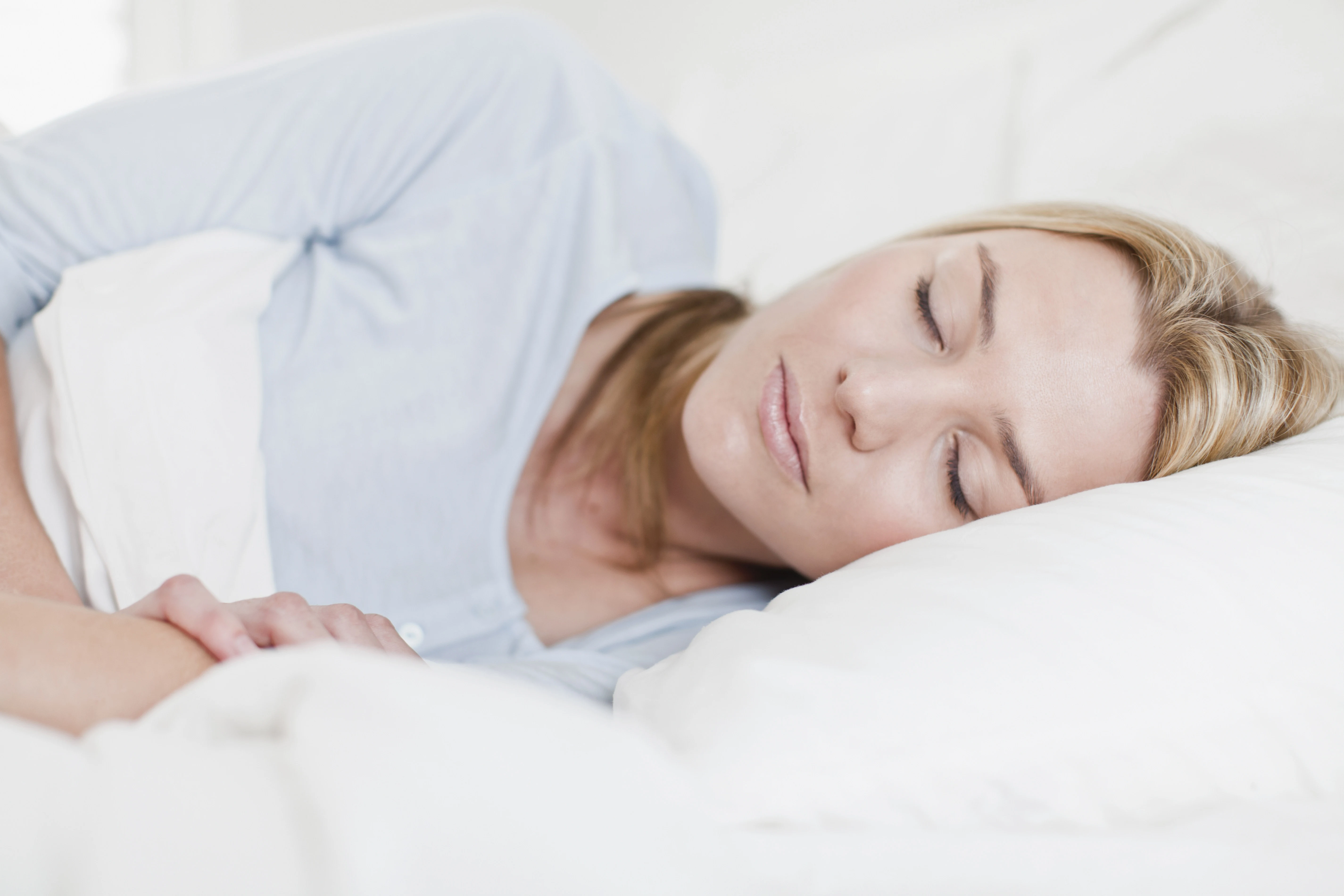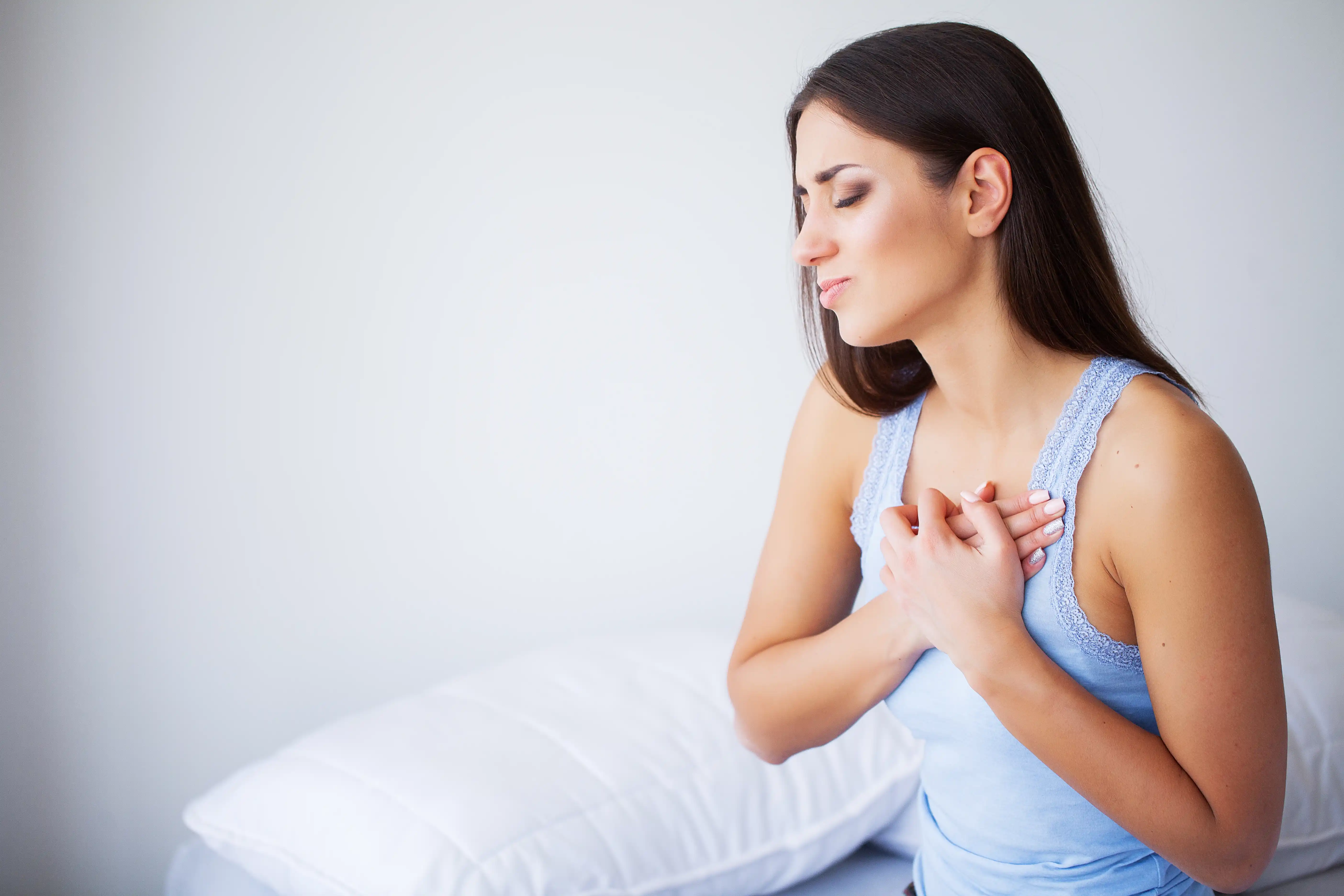Struggling to breathe while lying down can be alarming, especially when it disrupts sleep and makes resting flat uncomfortable, or even impossible. This condition is known as orthopnea, and it’s often a sign of an underlying health issue rather than a problem on its own.
In some cases, it may be mistaken for other nighttime breathing disorders like sleep apnea, which makes it important to understand the differences.
While it can feel similar to other breathing problems, orthopnea has distinct triggers and patterns. Understanding its causes, how it’s different from conditions like sleep apnea, and when to seek help is crucial for managing both your comfort and overall health.
In this article, we will explore whether sleeping sitting up helps with sleep apnea, who benefits most from this position, and practical tips for making it comfortable.
What Is Orthopnea?
Orthopnea is a type of breathing difficulty that occurs when a person lies flat. People with orthopnea often find relief by propping themselves up with pillows or sleeping in an upright position, as this helps reduce the pressure on their lungs and makes breathing easier.
Unlike obstructive sleep apnea, which involves pauses in breathing during sleep due to airway blockages, orthopnea is more closely linked to how fluid shifts or weakened heart or lung function affect breathing when lying down.
It’s not a disease in itself, but rather a symptom, most commonly of heart failure, but also sometimes related to lung conditions, obesity, or diaphragm dysfunction. The sensation can range from mild discomfort to severe breathlessness that demands immediate medical attention.
How It's Different From Other Breathing Disorders
Orthopnea may sound similar to other forms of breathlessness, but its key distinguishing factor is postural dependency; symptoms only occur or significantly worsen when lying down. Here's how it compares to other conditions.
- Dyspnea: Dyspnea refers to general shortness of breath, regardless of body position. Orthopnea, however, specifically occurs when lying flat and improves when sitting or standing, often signaling heart failure or fluid-related issues.
- Paroxysmal Nocturnal Dyspnea (PND): PND, a type of orthopnea, is when sudden nighttime episodes of severe breathlessness wake a person from sleep, often linked with fluid buildup from heart failure.
- Platypnea: Opposite of orthopnea, platypnea is shortness of breath that worsens when sitting or standing and improves when lying down.
- Trepopnea: Breathing difficulty that occurs when lying on one side but not the other, often associated with lung or heart disease.
- Hypopnea: Hypopnea is when shallow or reduced breathing occurs, often part of sleep apnea disorders, especially obstructive sleep apnea, where airflow decreases but doesn’t fully stop.
- Hypercapnia: Hypercapnia is a condition involving elevated carbon dioxide (CO₂) levels in the blood, often due to inadequate ventilation, and can occur alongside conditions like sleep apnea or severe lung disease.
Causes of Orthopnea

Orthopnea is most commonly linked to cardiovascular and respiratory conditions, but other factors like body weight, sleep posture, and even nerve or muscle disorders can also play a role. Here’s a breakdown of the most common causes.
Heart Failure
Heart failure, especially congestive heart failure (CHF), is the leading cause of orthopnea. When the heart can't pump efficiently, fluid backs up into the lungs (pulmonary congestion), making it harder to breathe. Lying flat worsens this issue because gravity no longer helps keep fluid away from the lungs, leading to a sensation of breathlessness.
Left Ventricular Dysfunction
When the left ventricle of the heart weakens or stiffens, it struggles to pump blood effectively to the body. This causes blood to pool in the lungs, increasing pulmonary pressure and triggering orthopnea. It’s a common early warning sign in patients with diastolic or systolic heart failure.
Obesity
Excess body weight, especially around the chest and abdomen, can compress the lungs and diaphragm when lying flat. This mechanical pressure reduces lung expansion and air exchange, making breathing more difficult during sleep or rest.
Sleep Position
Sometimes, orthopnea is directly related to the position of the body during sleep. Lying flat increases pressure on the chest, especially in people with pre-existing breathing or heart problems. Sleeping with an elevated upper body can significantly ease symptoms.
Chronic Obstructive Pulmonary Disease (COPD)
COPD, which includes emphysema and chronic bronchitis, affects airflow in and out of the lungs. In people with COPD, lying down can further limit lung capacity and increase mucus accumulation, leading to nighttime breathing difficulties similar to orthopnea.
Sleep Apnea and Related Disorders
Obstructive sleep apnea (OSA) can sometimes mimic orthopnea or worsen it. While OSA is caused by airway collapse during sleep, the overlap in symptoms, especially in those with coexisting heart issues, can make the two conditions hard to differentiate without proper testing.
Neuromuscular Conditions
Diseases that weaken the diaphragm or chest wall muscles, such as amyotrophic lateral sclerosis (ALS) or muscular dystrophy, can impair breathing when lying flat. These conditions reduce the ability of respiratory muscles to function against gravity, contributing to orthopnea.
Symptoms of Orthopnea
Orthopnea can vary in intensity from mild discomfort to severe breathlessness. Symptoms often worsen at night and may interfere with sleep and daily function.
- Difficulty Breathing When Lying Flat: The most recognizable symptom, individuals feel short of breath or experience a tight chest when lying on their back, often making it hard to relax or fall asleep.
- Need to Sleep Propped Up: Many people find they need to elevate their upper body using several pillows or sleep in a reclining chair to breathe easily and stay comfortable through the night.
- Coughing: A persistent dry or wet cough, often worse when lying down, may develop due to fluid buildup in the lungs, especially in those with heart failure.
- Chest Discomfort: Some may feel pressure, heaviness, or tightness in the chest during episodes of orthopnea, particularly when it's caused by a cardiac condition.
- Fatigue: Poor-quality sleep from nighttime breathing difficulties can lead to excessive daytime fatigue, low energy, and trouble concentrating or staying active.
How Orthopnea Affects Sleep

Orthopnea can have a major impact on sleep quality. Because symptoms are triggered or worsened when lying flat, many individuals experience frequent awakenings, poor rest, and increased stress surrounding bedtime. Over time, this can lead to chronic sleep deprivation and worsen overall health.
Difficulty Falling or Staying Asleep
People with orthopnea often struggle to fall asleep comfortably, as lying down quickly brings on breathlessness or chest tightness. Even after falling asleep, they may wake up frequently due to sudden shortness of breath, especially if they’ve accidentally shifted to a flatter position.
This cycle of disrupted sleep can contribute to insomnia, leading to inconsistent rest, poor sleep quality, and next-day tiredness.
Impact on REM and Deep Sleep
Breathing difficulties at night can interfere with the body’s ability to reach and maintain REM (rapid eye movement) and deep sleep stages, the most restorative parts of the sleep cycle.
In some cases, REM rebound may occur, where the body tries to compensate for lost REM sleep by entering it more quickly and intensely once breathing improves. Over time, poor sleep quality can also contribute to worsened heart or lung function, creating a vicious cycle.
Without sufficient time in these phases, individuals may wake up feeling unrefreshed, mentally foggy, or physically drained. Over time, poor sleep quality can also contribute to worsened heart or lung function, creating a vicious cycle.
Sleep Positioning and Pillow Support
To manage symptoms, many people with orthopnea resort to sleeping in an upright position, using multiple pillows or wedge cushions, or sleeping in a recliner.
Elevating the upper body helps gravity reduce fluid buildup in the lungs, making it easier to breathe. While this can provide relief, improper positioning may lead to neck or back discomfort over time if not done carefully.
How Is Orthopnea Diagnosed?
Diagnosing orthopnea involves identifying the underlying cause of the breathing difficulty since orthopnea itself is a symptom rather than a standalone condition. Doctors typically use a combination of patient history, physical exams, and targeted tests to uncover the root problem and guide treatment.
From Medical History to Tests
A thorough diagnostic process starts with understanding when and how symptoms appear, followed by focused testing to evaluate the heart, lungs, and sleep patterns.
- Physical Exam and Symptom Discussion: A doctor will ask detailed questions about your symptoms, such as when breathlessness occurs, how many pillows you sleep with, and whether it worsens at night. During the exam, they’ll listen to your lungs and heart for signs of fluid buildup or abnormal rhythms.
- Imaging and Heart/Lung Function Tests: Tests like chest X-rays, echocardiograms, or CT scans can reveal heart enlargement, fluid in the lungs, or other structural issues. Pulmonary function tests may also be used to assess lung strength and capacity, especially if COPD or another respiratory condition is suspected.
- Sleep Study (If Sleep Apnea Is Suspected): If symptoms suggest sleep-disordered breathing, like gasping, snoring, or choking at night, a polysomnography (sleep study) might be recommended. This test measures breathing patterns, oxygen levels, and sleep stages to rule out or confirm obstructive sleep apnea or related disorders.
When to See a Doctor
While occasional shortness of breath may not be serious, orthopnea should never be ignored, especially if it’s new, worsening, or interfering with your sleep.
It’s often a sign of an underlying health issue that requires medical attention. Knowing when to contact a doctor or seek urgent care can make a major difference in treatment outcomes.
Recognizing a Medical Emergency
Orthopnea can signal serious heart or lung problems. If symptoms come on suddenly or if you notice additional warning signs, you should seek help as soon as possible.
- Signs of Orthopnea May Indicate Heart or Lung Disease: If your breathing worsens when lying flat, especially when paired with leg swelling, persistent coughing, chest pressure, or rapid weight gain, it may point to conditions like congestive heart failure or pulmonary edema.
- When to Seek Immediate Care: Contact emergency services if you experience severe shortness of breath, chest pain, fainting, bluish lips or fingertips, or if you cannot lie down at all without gasping for air. These may be signs of a life-threatening emergency that needs urgent intervention.
Treatment Options for Orthopnea
Effective treatment for orthopnea focuses on addressing the underlying cause, whether it's related to the heart, lungs, weight, or sleep-disordered breathing.
In many cases, a combination of medical treatment, positional strategies, and lifestyle changes can significantly improve symptoms and overall quality of life.
Managing the Root Cause
- Heart Failure Treatment: If orthopnea is linked to heart failure, treatment may include diuretics (to reduce fluid buildup), ACE inhibitors, beta-blockers, and lifestyle changes to support heart health. In more severe cases, advanced therapies or surgery may be needed.
- CPAP or BiPAP for Sleep-Related Issues: If sleep apnea is a contributing factor, using Continuous Positive Airway Pressure (CPAP) or Bilevel Positive Airway Pressure (BiPAP) machines can help keep airways open during sleep, improving oxygen flow and reducing nighttime breathing difficulties.
- Oxygen Therapy or Medications: For those with chronic lung conditions like COPD, oxygen therapy, bronchodilators, or anti-inflammatory medications may be prescribed to improve breathing and reduce lung inflammation.
Positional Therapy
Simple adjustments in sleep positioning can provide significant relief. Many people benefit from using wedge pillows, adjustable beds, or sleeping in a recliner to keep the upper body elevated. These methods help gravity reduce fluid accumulation in the lungs and ease pressure on the chest and diaphragm.
Lifestyle Adjustments
Alongside medical treatment, adopting healthy lifestyle habits can significantly reduce orthopnea symptoms and improve overall well-being. These adjustments help support heart and lung function, reduce fluid buildup, and promote better sleep quality.
- Quit Smoking: Smoking damages the lungs and heart, worsening breathing difficulties and increasing the risk of respiratory infections. Quitting smoking improves lung capacity and cardiovascular health, making it easier to breathe both during the day and at night.
- Reduce Salt Intake: Excess salt causes the body to retain fluid, which can accumulate in the lungs and worsen orthopnea symptoms. Cutting back on salty foods helps control fluid retention, reducing pressure on the lungs and heart.
- Avoid Alcohol and Heavy Evening Meals: Alcohol and large meals before bedtime can cause acid reflux and disrupt sleep, making breathing problems worse. Limiting these helps reduce nighttime discomfort and promotes more restful sleep.
- Maintain a Consistent Sleep Schedule: Going to bed and waking up at the same times daily helps regulate your body’s internal clock, improving sleep quality and reducing the risk of sleep disruptions caused by orthopnea.
- Practice Good Sleep Hygiene: Creating a calm and comfortable sleep environment, such as keeping the bedroom dark, quiet, and cool, and avoiding screens or stimulants before bed, can help you fall asleep faster and stay asleep longer, minimizing orthopnea-related awakenings.
- Engage in Regular Physical Activity: Exercise supports weight management, strengthens respiratory muscles, and improves circulation, all of which contribute to easier breathing and better heart health over time.
FAQs
Can Orthopnea Be Caused by Sleep Apnea?
Yes, orthopnea can sometimes be linked to sleep apnea, especially obstructive sleep apnea (OSA). While orthopnea mainly results from fluid buildup or heart and lung issues, sleep apnea causes airway blockage during sleep, which can worsen breathing difficulties when lying down.
Can Orthopnea Be Treated?
Yes, orthopnea can be effectively managed by treating its underlying causes. This may include medications for heart failure, lifestyle changes like weight loss and quitting smoking, positional therapy to sleep upright, and treatments for related conditions like sleep apnea.
Is Orthopnea A Sign Of Heart Failure?
Orthopnea is often a key symptom of heart failure, particularly left-sided heart failure. It occurs because the weakened heart struggles to pump blood efficiently, causing fluid to accumulate in the lungs when lying flat.
How Many Pillows is Considered Orthopnea?
Needing to use two or more pillows to sleep comfortably due to breathlessness when lying flat is often considered a clinical indicator of orthopnea. However, this can vary by individual, so it’s important to consult a healthcare provider for proper evaluation.
Conclusions
Orthopnea is a common but often overlooked symptom that can significantly affect sleep and overall quality of life. It is usually a sign of an underlying health condition, most notably heart failure or lung disease.
Recognizing the symptoms early and seeking proper medical evaluation is crucial for effective treatment and preventing complications.
With a combination of medical care, lifestyle adjustments, and positional strategies, many people with orthopnea can find relief and improve their breathing both day and night.
Dom Abraham
As the lead content writer at Sleepiverse. Dom pours his heart into writing mattress reviews, bedding product reviews, and medically-reviewed health articles. Dom is from Portugal and likes to spend his free time writing on the beach as it gives him a sense of comfort. Aside from writing mattress reviews in front of the soothing beach view, Dom likes to experiment with new amazing food ideas.


